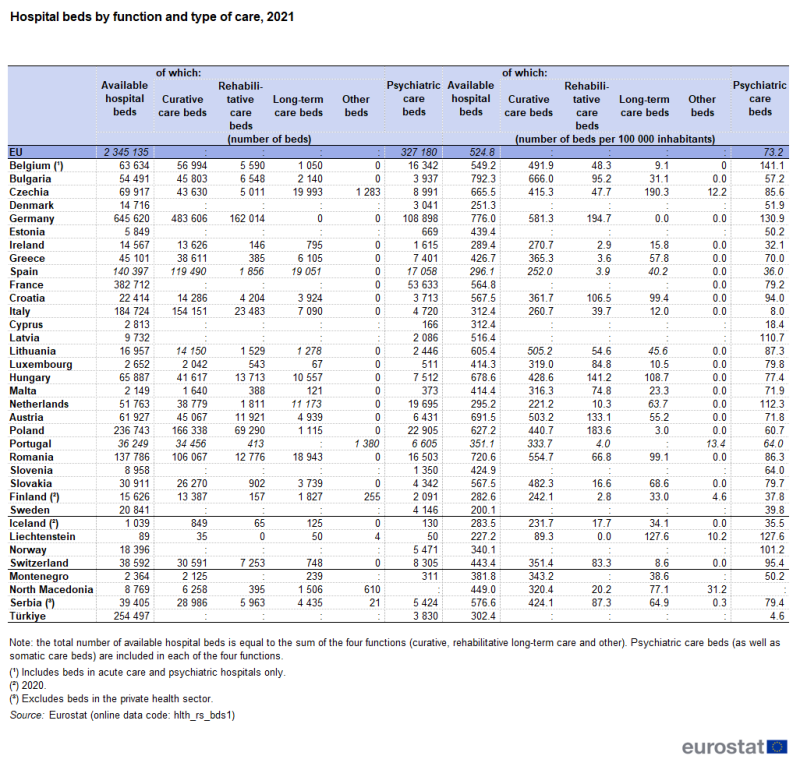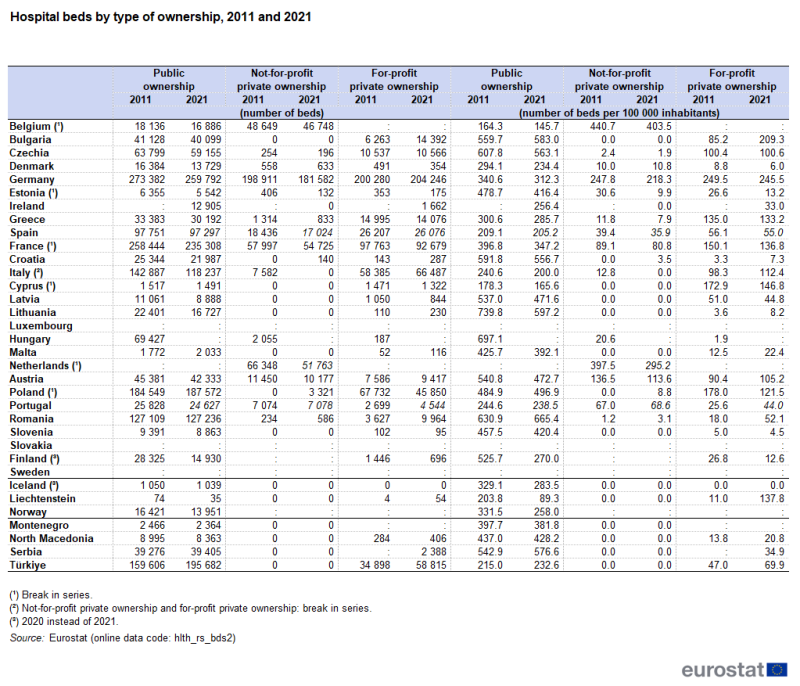Healthcare resource statistics - beds
Data extracted in September 2023.
Planned article update: November 2024.
Highlights
Among EU Member States, Bulgaria and Germany had the highest number of hospital beds relative to population size in 2021.
Most EU Member States reported fewer hospital beds per head of population in 2021 than 10 years earlier.
In 2021, Ireland reported a higher rate of occupancy for curative care beds than any other EU Member State.
Curative care beds in hospitals, 2021
This article presents an overview of European Union (EU) statistics related to the availability and occupancy of hospital beds as well as the availability of beds in nursing and other residential long-term care facilities. Hospital beds include beds for curative care, long-term care and rehabilitative care.
This article is one of a set of statistical articles concerning healthcare resources in the EU which forms part of an online publication health statistics.
This article includes data that may have been impacted by the COVID-19 pandemic and its related restrictions. For this reason, particular attention should be paid when comparing the 2021 data with data from earlier years.
In some EU Member States, healthcare resources were placed under intense pressure (particularly at the start of the pandemic) from an influx of patients with COVID-19; the availability of hospital beds, notably for intensive care, was often under the spotlight. The pandemic also resulted in a range of knock-on effects including, among others, some services being curtailed/postponed due to the number of COVID-19 patients, staff shortages within hospitals and day care centres due to infection/quarantine procedures, and patients' hindered access to medical services due to their own infection/quarantine as well as lockdown or travel restrictions.
Full article
Hospital beds
In 2021, there were 2.3 million hospital beds available for use across the EU. Around three quarters of these were for the curative care function. Most of the remainder were beds for rehabilitative care. Recent methodological changes in the classification of hospital beds have resulted in psychiatric care beds being included – alongside somatic care – among the various functions of beds (curative, rehabilitative, long-term care and other). However, a separate subtotal for psychiatric care beds (across all four categories) is also available (see Table 1).
Bulgaria, Germany and Romania had the highest numbers of hospital beds relative to population size
An analysis of the number of hospital beds in relation to population reveals that there were, on average, 525 hospital beds per 100 000 inhabitants in 2021 across the whole of the EU. Among the EU Member States, Germany recorded not only the highest number of hospital beds (646 000), but also the second highest number relative to population size, with 776 beds per 100 000 population (see Table 1). The only Member State with a higher ratio relative to its population size was Bulgaria, with an average of 792 hospital beds per 100 000 inhabitants. Romania recorded the third highest ratio, 721 hospital beds per 100 000 inhabitants. Spain, the Netherlands, Ireland, Finland (2020 data), Denmark and Sweden recorded the lowest numbers of hospital beds relative to their population size in 2021, all under 300 beds per 100 000 inhabitants.
The share of beds for the curative care function among all hospital beds in 2021 was highest in Portugal and Ireland, at 95.1 % and 93.5 %, respectively. Elsewhere, curative care beds accounted for less than 90.0 % of all hospital beds. Less than two thirds of all hospital beds were for curative care in Croatia, Hungary and Czechia (where the lowest share was recorded, at 62.4 %). Note that data on curative care beds are not available for seven EU Member States (see Table 1 for more details).
In Poland, beds for the rehabilitative care function accounted for 29.3 % of the total number of hospital beds in 2021, while this share was also above one fifth in Germany, Hungary and Luxembourg. In 11 of the 22 Member States for which data are available, this share was below 10.0 %, with the lowest shares (below 2.0 %) in Spain, Portugal, Finland (2020 data), Ireland and Greece.
In most of the 21 EU Member States for which data are available, beds for the long-term care function accounted for less than 15 % of the total number of hospital beds in 2021, with only Hungary (16.0 %), Croatia (17.5 %), the Netherlands (21.6 %) and Czechia (28.6 %) reporting higher shares. This share was 0.5 % in Poland and there were no long-term care beds in Germany.
Decreasing availability of hospital beds in most EU Member States
Between 2011 and 2021, the total number of hospital beds in the EU decreased by 6.2 %. Across the vast majority of EU Member States, the number of hospital beds (in absolute terms) was lower in 2021 than it had been in 2011. The largest contraction in the number of hospital beds was recorded in Finland, where overall bed numbers fell by 47.5 % between 2011 and 2020. There were five Member States where the total number of hospital beds rose between 2011 and 2021: Portugal (up 1.8 %), Romania (up 5.2 %), Bulgaria (up 15.0 %), Malta (up 17.8 %) and Ireland (up 21.3 %); note that there are breaks in series for Ireland and Malta.
Figures 1 to 3 provide an analysis of the change between 2011 and 2021 in the availability (relative to the size of population) for three specific functions: curative, rehabilitative and long-term care. These changes in the number of hospital beds can be compared with changes in the average length of stays for in-patients and the number of hospital discharges in order to analyse developments in the supply of and demand for hospital beds.
Six of the 18 EU Member States for which data are available recorded an increase in their number of curative care beds in hospitals (relative to the size of their population) between 2011 and 2021 (see Figure 1 for information about the coverage for individual Member States). There were relatively small increases in Spain and Portugal (both increasing by 3–4 beds per 100 000 inhabitants). Bed numbers per 100 000 inhabitants rose at a faster pace in Ireland (break in series), Romania, Malta (break in series) and Bulgaria, with increases of 28, 69, 75 and 120 beds per 100 000 inhabitants respectively. During the period under consideration, three Member States experienced decreases in excess of 100 beds per 100 000 inhabitants: Luxembourg (2013–2021), Austria and Lithuania, down 104, 110 and 120 beds per 100 000 inhabitants, respectively.
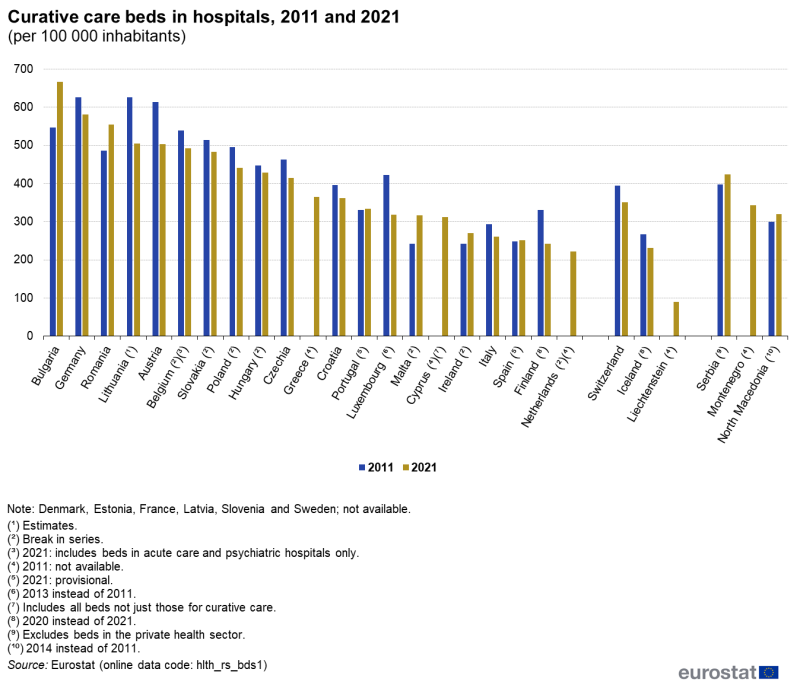
(per 100 000 inhabitants)
Source: Eurostat (hlth_rs_bds1)
Rehabilitative care beds accommodate hospital patients with the intent to stabilise, improve or restore impaired body functions and structures. During the period 2011 to 2021, the number of rehabilitative beds relative to population size increased in about half of the EU Member States for which data are available, 9 out of 17 (see Figure 2 for details of the data coverage). The number of rehabilitative care beds increased by more than 20 beds per 100 000 inhabitants in Poland (break in series), Austria and Bulgaria: the latter two recorded the highest increases, both with an additional 27 beds per 100 000 inhabitants. By contrast, the number of rehabilitative care beds relative to population size decreased in eight Member States between 2011 and 2021. Decreases were generally no greater than 10 beds per 100 000 inhabitants, although larger bed losses were reported for Germany (down 18 beds per 100 000 inhabitants) and Hungary (down 19 beds per 100 000 inhabitants; break in series).
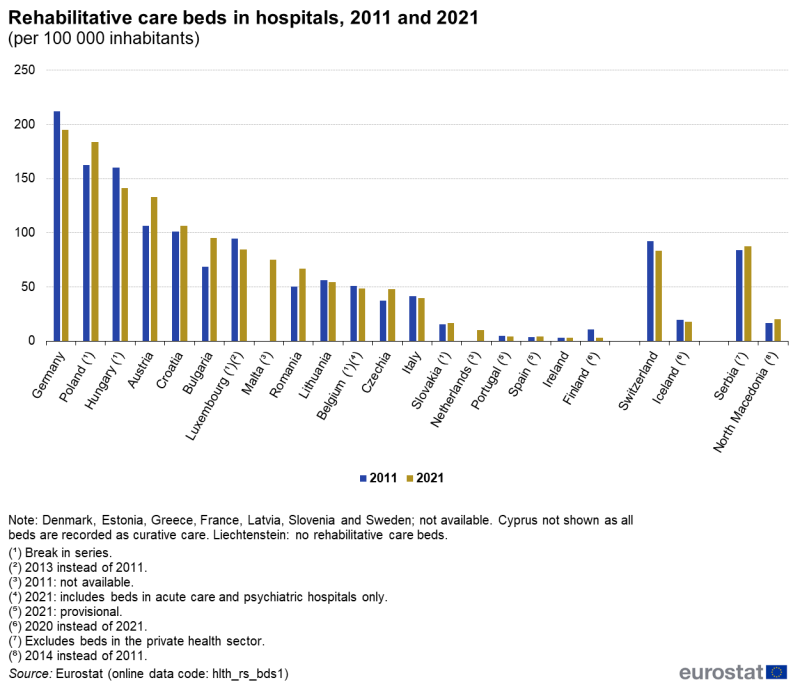
(per 100 000 inhabitants)
Source: Eurostat (hlth_rs_bds1)
Among the 16 EU Member States for which data are available (see Figure 3 for details of the data coverage), there was mainly a downward development in the number of long-term care beds per 100 000 inhabitants during the period 2011 to 2021. Note that Germany did not report any long-term care beds in hospitals. There were 11 Member States where there was a decrease in the number of long-term care beds relative to population size and five where there was an increase. By far, the largest fall in the number of long-term care beds per 100 000 inhabitants was recorded in Finland, dropping from 209 to 33 beds per 100 000 inhabitants between 2011 and 2020. The largest increase in the number of long-term care beds was in Malta (21 additional beds per 100 000 inhabitants; break in series).
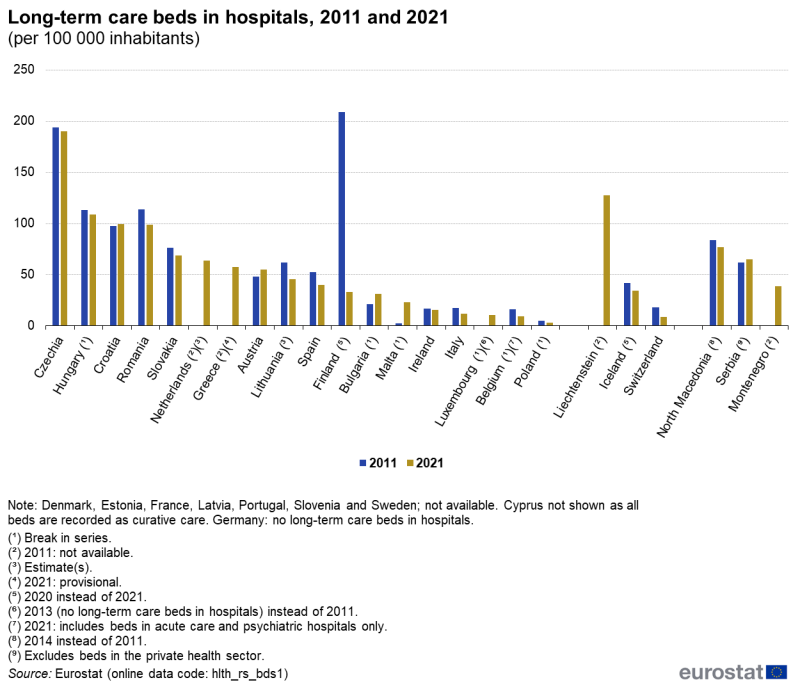
(per 100 000 inhabitants)
Source: Eurostat (hlth_rs_bds1)
Half of the EU Member States reported an increase in the number of beds in for-profit private hospitals
Table 2 provides an analysis of the number of hospital beds based on the type of hospital ownership. Publicly-owned hospitals are those under the ownership or control of a government unit or another public corporation. Privately-owned hospitals may be distinguished as either not-for-profit (no financial gain for the unit(s) that establishes, controls or finances them) or for-profit.
In 2021, at least 90 % of hospital beds in Slovenia, Lithuania, Croatia, Finland (2020 data), Estonia, Malta, Denmark, Romania and Latvia were in publicly-owned hospitals. At the other end of the range, all of the hospital beds in the Netherlands were in the private sector (not-for-profit), while a majority of the hospital beds in Germany (60 %) and Belgium (73 %) were in privately-owned hospitals. Aside from these three EU Member States, the highest share of beds in privately-owned hospitals was found in Cyprus (47 %).
In absolute terms, the largest number of hospital beds in for-profit private hospitals was in Germany where there were 204 200 beds in 2021, more than double the next highest number, 92 700 in France. There were 181 600 hospital beds in Germany in not-for-profit private hospitals, which was also the highest number recorded among the EU Member States; this was followed by France (54 700) and the special case of the Netherlands, where the entire stock of hospital beds (51 800 beds) was in the not-for-profit private sector.
Across the 20 EU Member States for which data are available for both 2011 and 2021 (see Table 2 for details of the data coverage), the development of the number of hospital beds in for-profit private hospitals was mixed. There was an expansion in the number of beds in 10 Member States, most notably in Romania, Bulgaria, Malta, Lithuania and Croatia where the number of hospital beds in for-profit private hospitals more than doubled. In absolute terms, the largest increases in bed numbers were recorded in Bulgaria, Italy (note that there is a break in series), Romania and Germany, where for-profit private hospitals added, respectively, 8 100, 8 100, 6 300 and 4 000 beds between 2011 and 2021.
Highest curative care beds occupancy rates in Ireland
Among the EU Member States, the occupancy rate of curative care beds in 2021 was generally situated within the range of 56 % to 73 % (see Figure 4 for details of data coverage). Higher rates were recorded in Portugal (77.8 %) and Ireland (82.8 %) while lower rates were recorded in Cyprus (51.8 %; includes all beds, not just curative) and Hungary (51.5 %).
There was a clear pattern among the EU Member States with respect to the change in occupancy rates of curative cure beds between 2011 and 2021. Among the 19 EU Member States for which data are available (see Figure 4 for details of data coverage), all recorded decreases. In percentage point (pp) terms, the largest decrease in the occupancy rate was recorded in Cyprus (a decrease of 39.1 pp; the definition differs and there is a break in series). Decreases between 10 pp and 20 pp were also observed in Hungary, Lithuania, Czechia, Croatia and Slovenia. The smallest decreases were in Luxembourg (down 1.1 pp; break in series) and Portugal (down 0.8 pp).
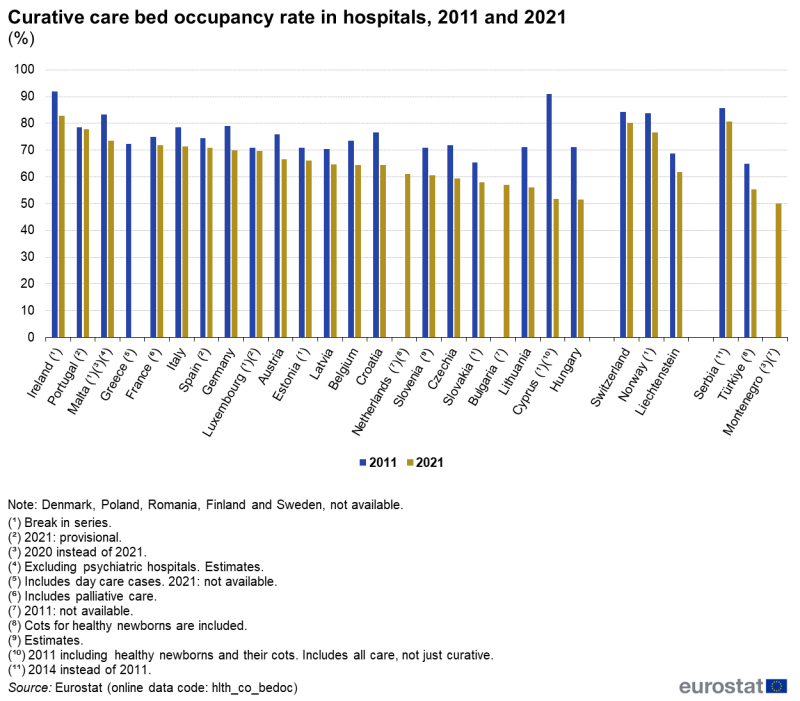
(%)
Source: Eurostat (hlth_co_bedoc)
Beds in nursing and other residential long-term care facilities
The number of beds in nursing and other residential long-term care facilities relative to population size increased in most EU Member States
While the analysis presented so far has focused on beds in hospitals, this final section looks at beds in nursing and other residential long-term care facilities. In 2021, there were approximately 3.5 million beds in these facilities across the 25 EU Member States for which data are available (no data available for Greece or Portugal; 2020 data for Finland).
Relative to population size in 2021, the highest number of beds in nursing and other residential long-term care facilities was recorded in the Netherlands, with 1 457 per 100 000 inhabitants (see Figure 5). Belgium, Malta and Sweden recorded ratios between 1 280 and 1 288 beds per 100 000 inhabitants. In most of the remaining EU Member States for which data are available (no data for Greece or Portugal), the number of beds in nursing and other residential long-term care facilities exceeded 700 per 100 000 inhabitants.
- Ireland, Italy and Cyprus had 633, 503 and 360 beds per 100 000 inhabitants, respectively.
- There were between 201 and 259 beds per 100 000 inhabitants in Latvia (coverage is broader), Croatia, Romania and Poland.
- The lowest number of beds was in Bulgaria (26 per 100 000 inhabitants).

(per 100 000 inhabitants)
Source: Eurostat (hlth_rs_bdltc)
A comparison of 2011 and 2021 data reveals that there was an increase in bed numbers per 100 000 inhabitants in most of the EU Member States for which data are available (no data for Greece, Cyprus or Portugal). Relative to population size, the number of beds in nursing and other residential long-term care facilities fell in Sweden, Denmark, Latvia and Bulgaria, although all four of these Member States reported a break in series. The largest increases were in the Netherlands, Luxembourg, Malta and Estonia, again all with a break in series. Among the Member States without a break in series, the largest increase was in Slovakia (up 182 beds 100 000 inhabitants) and the smallest increase was in Poland (up 28 beds 100 000 inhabitants).
Source data for tables and graphs
Data sources
Key concepts
Hospitals comprise licensed establishments primarily engaged in providing medical, diagnostic and treatment services that include physician, nursing and other health services to in-patients, and the specialised accommodation services required by in-patients. Hospitals may also provide out-patient services as a secondary activity. Speciality hospitals, including mental health and substance abuse hospitals, are also covered.
Long-term care institutions refer to nursing and other residential care facilities which provide accommodation and long-term care as a package. Beds in nursing and other residential long-term care facilities are recorded separately from hospital beds.
Hospital beds are those beds which are regularly maintained and staffed and immediately available for the care of admitted patients. Occupied and unoccupied beds are both included. Excluded are recovery trolleys and beds for same day care (day care and out-patient care), provisional and temporary beds. Hospital beds can be partitioned by function and by category/type of care.
Total hospital beds by function = curative (acute) care beds + rehabilitative care beds + long-term care beds + other hospital beds
- Curative care beds in hospitals are for patients where the principal clinical intent is to do one or more of the following: manage labour (obstetric), perform surgery, cure or treat (including relieving symptoms, reducing severity, or protecting against exacerbation and/or complication) non-mental illness or injury, perform diagnostic or therapeutic procedures. They include beds for psychiatric and non-psychiatric curative (acute) care, from general hospitals, mental health hospitals and other specialised hospitals. Beds for palliative and long-term nursing care are recorded under long-term care.
- Rehabilitative care beds in hospitals are beds accommodating patients with the principal intent to stabilise, improve or restore impaired body functions and structures, compensate for the absence or loss of body functions and structures, improve activities and participation and prevent impairments, medical complications and risks. They include beds for psychiatric and non-psychiatric curative (acute) care, from general hospitals, mental health hospitals and other specialised hospitals.
- Long-term care beds in hospitals are for patients requiring long-term care due to chronic impairments and a reduced degree of independence in activities of daily living, including palliative care. They include beds for psychiatric and non-psychiatric curative (acute) care, from general hospitals, mental health hospitals and other specialised hospitals.
- Other beds include all other beds in hospitals not elsewhere classified.
Total hospital beds by category/type of care = somatic care beds + psychiatric care beds
- Somatic care means healthcare relating to the body, as distinguished from psychiatric care.
- Psychiatric care means healthcare concerning the mind, for example, dealing with mental and behavioural disorders. Psychiatric care beds include all beds in mental health and substance abuse hospitals, as well as beds in psychiatric departments of general and specialty hospitals.
Healthcare resources
Statistics on healthcare resources (such as beds in hospitals as well as nursing and other residential long-term care facilities) are documented in this background article which provides information on the scope of the data, its legal basis, the methodology employed, as well as related concepts and definitions.
For country specific notes on the collection of healthcare non-expenditure statistics, please refer to the annexes at the end of the national metadata reports accessible from links at the beginning of the European metadata report.
Symbols
Tables in this article use the following notation:
| Value in italics | estimate or provisional data; |
| Value is – | not relevant or not applicable; |
| Value is : | not available. |
Context
Indicators concerning the number of hospital beds (and their function and category/type of care) complement information on hospital personnel and equipment to provide an overview of the resources available for delivering healthcare in hospitals. The European core health indicators (ECHI) shortlist includes an indicator on 'hospital beds' by function and category/type of care in the chapter on health services. It should be noted that the information on hospital beds only covers beds for in-patient care: many hospitals also provide day care and out-patient care and beds used for these services are excluded from the information presented.
In many areas, technological developments have reduced the average length of stay for in-patient procedures or replaced procedures requiring in-patient care with ones that can be provided to day care or out-patients. As such, it is commonplace to find the total number of available hospital beds falling over time in many of the EU Member States.
Direct access to
Online publications
Healthcare resources
- Physicians
- Nursing and caring professionals
- Dentists, pharmacists and physiotherapists
- Medical technology
Methodology
General health statistics articles
- Health (t_hlth)
- Health care (t_hlth_care)
- Hospital beds (tps00046)
- Available beds in hospitals by NUTS 2 regions (tgs00064)
- Health care (t_hlth_care)
- Health (hlth)
- Health care (hlth_care)
- Health care resources (hlth_res)
- Health care facilities (hlth_facil)
- Available beds in hospitals by NUTS 2 region (hlth_rs_bdsrg2)
- Beds in nursing and other residential long-term care facilities (hlth_rs_bdltc)
- Devices for medical imaging (hlth_rs_medim)
- Hospital beds by hospital ownership (hlth_rs_bds2)
- Hospital beds by function and type of care (hlth_rs_bds1)
- Health care facilities (hlth_facil)
- Health care activities (hlth_act)
- Inpatient curative care bed occupancy rate by type of care (hlth_co_bedoc)
- Health care resources (hlth_res)
Manuals and guidelines
Metadata
- Healthcare non-expenditure statistics (ESMS metadata file – hlth_res_esms)
